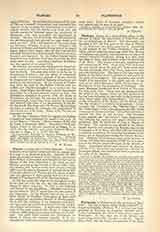

Flavigny, Abbey of, a Benedictine abbey in the Diocese of Dijon, the department of Cote-d’Or, and the arrondissement of Semur. This monastery was founded in 721, the first year of the reign of Thierry IV, by Widerad, who richly endowed it. According to the authors of the “Gallia Christiana“, the new abbey, placed under the patronage of St. Prix, Bishop of Clermont, and martyr, was erected on the site of an ancient monastic foundation, dating, it is said, from the time of Clovis, and formerly under the patronage of St. Peter. This titular eventually overshadowed and superseded St. Prix. Pope John VIII dedicated the new church about the year 877, from which time the first patronage, that of St. Peter, appears to have prevailed definitively. The fame of Flavigny was due partly to the relics which it preserved, and partly to the piety of its religious. The monastery was at the height of its reputation in the eighth century, in the time of the Abbot Manasses, whom Charlemagne authorized to found the monastery of Corbigny. The same Manasses transferred from Volvic to Flavigny the relics of St. Prix. There were also preserved here the relics of St. Regina, whom her acts represent as having been beheaded for the faith in the borough of Alise (since called Alise-Sainte-Reine). The history of the translation of St. Regina (21—March 22, 864) was the subject of a contemporary account. Unfortunately the “Chronicle”, the “Martyrology“, and the “Necrology” of the Abbot Hugues, and the “Livre contenant les chores notables” have either perished or contain few facts of real interest. The liturgical books, notably the “Lectionary“, have disappeared. The abbatial list contains few names worthy to be preserved, with the exception of that of Hugues of Flavigny. The monastery was rebuilt in the seventeenth century and occupied by Benedictines of the Congregation of St. Maur, who were actively employed in research concerning the historical documents of the abbey, but it disappeared during the French Revolution. Hitherto it had formed a part of the Diocese of Autun; but after the concordat of 1802 the new partition of the diocese placed Flavigny in the Diocese of Dijon. Lacordaire rebuilt and restored all that remained of the monastery surrounded by a portion of its ancient estate, and established there a convent of the order of St. Dominic.
H. LECLERCQ

